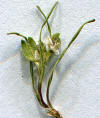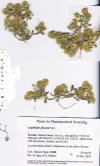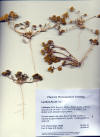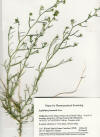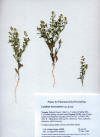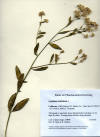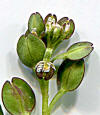|
Lepidium appelianum
|
Lepidium chalapense Utah—Great Basin Desert-Bonneville Basin Region. Millard Co.: Sevier Desert region, S of Amora along earth road off Hwy 24; 38º49'30.5", 111º56.28.7", 5430 ft. Shadscale scrub (Sarcobatus, Atriplex confertifolia, Tetradymia glabrata). Erect coarse herb with white flowers, spreading extensively by rhizomes. Of local occurrence. Sample of entire plant (rt-rh-st-lf-fl-fr), Richard Spjut & Paul Burchstaed 16369, 28 June 2008
|
Lepidium
dictyotum
|
|
Lepidium flavum |
Lepidium flavum |
Lepidium flavum
|
|
Lepidium flavum |
Lepidium fremontii |
Lepidium fremontii
|
|
Lepidium lasiocarpum |
Lepidium lasiocarpum
|
Lepidium latifolium
|
Lepidium montanum |
Lepidium nitidum Elkhorn Plain, CA |
Lepidium perfoliatum Nevada. Toiyabe Range, Kingston Creek; 39º17.508, 117º07.322, 6800 ft. Dry ground beyond shrub-willow community along narrow ravine bordered by sagebrush, Rosa nutkana, and Cercocarpus ledifolius along with herbs Carex spp., Juncus drummondii, Frasera speciosa, Dodecatheon pulchellum. extending into meadows with stands of Veratrum californicum that form 51-75% cover over an area 3-4 m wide and ~500 m in length up the ravine. 9 July 2009.
|
|
Trees and Shrubs of Kern County (Jan 2013) Lepidium fremontii S. Watson 1971. Desert alyssum. Subshrub, densely branched, to 60 cm; leaves alternate, narrow threadlike, entire or irregularly divided into narrow segments, 2–5 cm; flowers Mar–May, white, along short scape-like stems, petals 4; fruit heart-shaped, slightly notched at apex, compressed contrary to the center partition, with reticulate ridges and depressions. Common in the Mojave Desert below 5,000 ft to Utah and Arizona. Type from Mojave River, CA. Kern Co.: Generally gravel slopes and flats in the Mojave Desert region, widely distributed in the county, occurring between 600 and 1220 m (CCH). Pharmacological References Cicero AF, Bandieri E, Arletti R. 2001. Lepidium meyenii Walp. improves sexual behaviour in male rats independently from its action on spontaneous locomotor activity. J. Ethnopharmacol. 75(2-3): 225–229. “Lepidium meyenii Walpers (Maca) is traditionally employed in the Andean region for its supposed properties to improve energy and fertility. The aim of this study was to evaluate the effect of acute and chronic Maca pulverised root oral administration on rat sexual behaviour. Sixty male sexually experienced rats (20 group) were daily treated for 15 days with Maca 15 mg kg(-1), Maca 75 mg kg(-1) or saline 0.5 ml kg(-1). The following sexual performance parameters were evaluated at first and last day of treatment: 1st mount (ML), 1st intromission (IL), ejaculation (EL) and postejaculatory (PEL) latencies, intercopulatory interval (ICI) and copulatory efficacy (CE). An activity cage test was carried out to evaluate if Maca-induced locomotion changes could indirectly improve rat sexual performances. It was observed that both lower and higher Maca doses acutely decreased ML, IL and ICI in a significant way (P < 0.05), while only the 75 mg kg(-1) dose decreased the PEL (T = 29, P < 0.05). This effect seems to be the only one dose-dependent. After 15 days of treatment, both doses are able to significantly decrease ML, IL, EL and PEL, while the 75 mg kg(-1) dose decreased the ICI (T = 40, P < 0.05) too. IL, EL and PEL variations seem to be dose-related after chronic treatment. Moreover, chronic Maca treatment induced an apparently not dose-related increase in rat locomotion, during the second 10-min period of observation in the activity cage. The late in Maca-induced locomotion modification excludes that improvement of tested sexual performance parameters is related to an increase in rat aspecific activity. Thus, it was concluded that both acute and chronic Maca oral administration significantly improve sexual performance parameters in male rats.” Cui B., B. L. Zheng, K. He and Q. Y. Zheng. 2003. Imidazole alkaloids from Lepidium meyenii. J. Nat. Prod. 66(8):1101–1103. “Two new imidazole alkaloids (lepidiline A and lepidiline B) have been isolated from a root extract of Lepidium meyenii with the common name Maca and identified as 1,3-dibenzyl-4,5-dimethylimidazolium chloride (1) and 1,3-dibenzyl-2,4,5-trimethylimidazolium chloride (2), respectively. The structures of these two new compounds were determined by spectroscopic methods, as well as single-crystal X-ray diffraction performed on compound 1.” Eddouks M. and M. Maghrani. 2007. Effect of Lepidium sativum L. on renal glucose reabsorption and urinary TGF-beta1 levels in diabetic rats. Phytother. Res. Dec. “The purpose of this study was to determine the mechanism underlying the hypoglycaemic activity of the aqueous extract perfusion of Lepidium sativum L. (LS) in normal and streptozotocin-induced diabetic rats. The aqueous LS extract was administered intravenously and the blood glucose levels were determined within 4 h of treatment. Plasma insulin concentrations and glycosuria were determined. The 24 h urinary transforming growth factor-beta1 (ELISA) was evaluated in diabetic and control rats 15 days after oral treatment with the aqueous LS extract at a dose of 20 mg/kg.The study showed that LS at a dose of 10 mg/kg/h reduced blood glucose levels both in normal and diabetic rats (p < 0.001). At the same time as a potent increase of glycosuria was observed both in normal and diabetic rats (p < 0.001). In addition, oral administration of LS for 15 days normalized glycaemia (p < 0.001), enhanced glycosuria (p < 0.05 vs diabetic control) and decreased the amount of urinary TGF-beta1 (p < 0.01) in diabetic rats.It is concluded that the aqueous LS extract caused a potent inhibition of renal glucose reabsorption which in turn reduced blood sugar. This renal effect is at least one mechanism explaining the observed hypoglycaemic activity of this plant in normal and diabetic rats.” Gonzales GF and L. G. Valerio Jr. 2006. Medicinal plants from Peru: a review of plants as potential–agents against cancer. Anticancer Agents Med. Chem.. 6(5): 429–444. “Natural products have played a significant role in drug discovery and development especially for agents against cancer and infectious disease. An analysis of new and approved drugs for cancer by the United States Food and Drug Administration over the period of 1981-2002 showed that 62% of these cancer drugs were of natural origin. Natural compounds possess highly diverse and complex molecular structures compared to small molecule synthetic drugs and often provide highly specific biological activities likely derived from the rigidity and high number of chiral centers. Ethnotraditional use of plant-derived natural products has been a major source for discovery of potential medicinal agents. A number of native Andean and Amazonian medicines of plant origin are used as traditional medicine in Peru to treat different diseases. Of particular interest in this mini-review are three plant materials endemic to Peru with the common names of Cat's claw (Uncaria tomentosa), Maca (Lepidium meyenii), and Dragon's blood (Croton lechleri) each having been scientifically investigated for a wide range of therapeutic uses including as specific anti-cancer agents as originally discovered from the long history of traditional usage and anecdotal information by local population groups in South America. Against this background, we present an evidence-based analysis of the chemistry, biological properties, and anti-tumor activities for these three plant materials. In addition, this review will discuss areas requiring future study and the inherent limitations in their experimental use as anti-cancer agents.” Gonzales G. F., A. Córdova, K. Vega, A. Chung, A.Villena, C. Góñez and S. Castillo. 2002. Effect of Lepidium meyenii (MACA) on sexual desire and its absent relationship with serum testosterone levels in adult healthy men. Andrologia. 34(6): 367–372. “This study was a 12-week double blind placebo-controlled, randomized, parallel trial in which active treatment with different doses of Maca Gelatinizada was compared with placebo. The study aimed to demonstrate if effect of Maca on subjective report of sexual desire was because of effect on mood or serum testosterone levels. Men aged 21-56 years received Maca in one of two doses: 1,500 mg or 3,000 mg or placebo. Self-perception on sexual desire, score for Hamilton test for depression, and Hamilton test for anxiety were measured at 4, 8 and 12 weeks of treatment. An improvement in sexual desire was observed with Maca since 8 weeks of treatment. Serum testosterone and oestradiol levels were not different in men treated with Maca and in those treated with placebo (P:NS). Logistic regression analysis showed that Maca has an independent effect on sexual desire at 8 and 12 weeks of treatment, and this effect is not because of changes in either Hamilton scores for depression or anxiety or serum testosterone and oestradiol levels. In conclusion, treatment with Maca improved sexual desire.” Gonzales GF, Cordova A, Gonzales C, Chung A, Vega K, Villena A. 2001. Lepidium meyenii (Maca) improved semen parameters in adult men. Asian J. Androl. 3(4):301–303. “The present study was designed to determine the effect of a 4-month oral treatment with tablets of Lepidium meyenii (Maca) on seminal analysis in nine adult normal men aged 24-44 years old. Nine men received tablets of Maca (1500 or 3000 mg/day) for 4 months. Seminal analysis was performed according to guidelines of the World Health Organization (WHO). Serum luteinizing hormone (LH), follicle stimulating hormone (FSH), prolactin (PRL), testosterone (T) and estradiol (E2) were measured before and after treatment. RESULTS: Treatment with Maca resulted in increased seminal volume, sperm count per ejaculum, motile sperm count, and sperm motility. Serum hormone levels were not modified with Maca treatment. Increase of sperm count was not related to dose of Maca. Maca improved sperm production and sperm motility by mechanisms not related to LH, FSH, PRL, T and E2.” Muhammad I., J. Zhao, D. C. Dunbar and I. A. Khan. 2002. Constituents of Lepidium meyenii 'maca'. Phytochemistry 59(1): 105–110. “The tubers of Lepidium meyenii contain the benzylated derivative of 1,2-dihydro-N-hydroxypyridine, named macaridine, together with the benzylated alkamides (macamides), N-benzyl-5-oxo-6E,8E-octadecadienamide and N-benzylhexadecanamide, as well as the acyclic keto acid, 5-oxo-6E,8E-octadecadienoic acid. The structure elucidation of the isolated compounds was based primarily on 1D and 2D NMR spectroscopic analyses, including 1H-1H COSY, 1H-13C HMQC, 1H-13C HMBC and 1H-1H NOESY experiments, as well as from 1H-15N NMR HMBC correlations for macaridine and N-benzylhexadecanamide.” Navarro E., J. Alonso, R. Rodriguez, J. Trujillo and J. Boada. 1994. Diuretic action of an aqueous extract of Lepidium latifolium L. J. Ethnopharmacol. 41(1-2): 65–69. “An aqueous extract of Lepidium latifolium L. given orally and intraperitoneally considerably enhanced urinary excretion (UV) in rats with respect to control groups. A slight increase in ion excretion was also observed. Other parameters such as specific gravity, nitrite, pH, glucose, ketone bodies, urobilinogen, and blood were also studied. A good correlation for the dosage rat/man for the aqueous extract was achieved.
|
||




